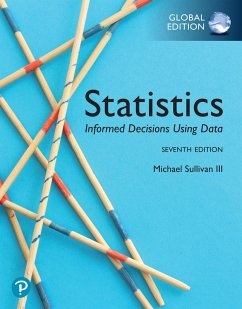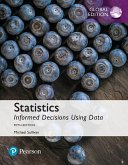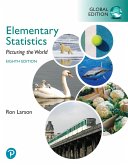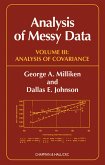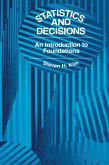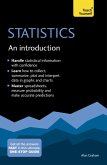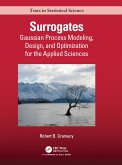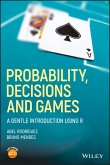Statistics: Informed Decisions Using Data, Global Edition (eBook, ePUB)


Alle Infos zum eBook verschenken

Statistics: Informed Decisions Using Data, Global Edition (eBook, ePUB)
- Format: ePub
- Merkliste
- Auf die Merkliste
- Bewerten Bewerten
- Teilen
- Produkt teilen
- Produkterinnerung
- Produkterinnerung

Hier können Sie sich einloggen

Bitte loggen Sie sich zunächst in Ihr Kundenkonto ein oder registrieren Sie sich bei bücher.de, um das eBook-Abo tolino select nutzen zu können.
Statistics: Informed Decisions Using Data helps you see the bigger picture and make informed choices for real-life situations such as buying a car, investing money, and choosing a place to live. It offers a practical emphasis that shows how statistics is connected not only to concepts, but to our world at large.
The 7th Edition adds a new set of Threaded Health and Nutrition Problems, drawing on National Health and Nutrition Examination Survey data obtained from the Centers for Disease Control and Prevention (CDC). This revision also adds a wealth of new and updated exercises, examples, and much more.…mehr
- Geräte: eReader
- ohne Kopierschutz
- eBook Hilfe
- Größe: 367.66MB
![Statistics: Informed Decisions Using Data, Global Edition (eBook, PDF) Statistics: Informed Decisions Using Data, Global Edition (eBook, PDF)]() Michael SullivanStatistics: Informed Decisions Using Data, Global Edition (eBook, PDF)42,95 €
Michael SullivanStatistics: Informed Decisions Using Data, Global Edition (eBook, PDF)42,95 €![Elementary Statistics: Picturing the World, Global Edition (eBook, ePUB) Elementary Statistics: Picturing the World, Global Edition (eBook, ePUB)]() Ron LarsonElementary Statistics: Picturing the World, Global Edition (eBook, ePUB)42,95 €
Ron LarsonElementary Statistics: Picturing the World, Global Edition (eBook, ePUB)42,95 €![Analysis of Messy Data, Volume III (eBook, ePUB) Analysis of Messy Data, Volume III (eBook, ePUB)]() George A. MillikenAnalysis of Messy Data, Volume III (eBook, ePUB)157,95 €
George A. MillikenAnalysis of Messy Data, Volume III (eBook, ePUB)157,95 €![Statistics and Decisions (eBook, ePUB) Statistics and Decisions (eBook, ePUB)]() S. H. KimStatistics and Decisions (eBook, ePUB)43,95 €
S. H. KimStatistics and Decisions (eBook, ePUB)43,95 €![Statistics: An Introduction: Teach Yourself (eBook, ePUB) Statistics: An Introduction: Teach Yourself (eBook, ePUB)]() Alan GrahamStatistics: An Introduction: Teach Yourself (eBook, ePUB)3,99 €
Alan GrahamStatistics: An Introduction: Teach Yourself (eBook, ePUB)3,99 €![Surrogates (eBook, ePUB) Surrogates (eBook, ePUB)]() Robert B. GramacySurrogates (eBook, ePUB)42,95 €
Robert B. GramacySurrogates (eBook, ePUB)42,95 €![Probability, Decisions and Games (eBook, ePUB) Probability, Decisions and Games (eBook, ePUB)]() Abel RodríguezProbability, Decisions and Games (eBook, ePUB)44,99 €
Abel RodríguezProbability, Decisions and Games (eBook, ePUB)44,99 €-
-
-
The 7th Edition adds a new set of Threaded Health and Nutrition Problems, drawing on National Health and Nutrition Examination Survey data obtained from the Centers for Disease Control and Prevention (CDC). This revision also adds a wealth of new and updated exercises, examples, and much more.
Dieser Download kann aus rechtlichen Gründen nur mit Rechnungsadresse in A, B, BG, CY, CZ, D, DK, EW, E, FIN, F, GR, HR, H, IRL, I, LT, L, LR, M, NL, PL, P, R, S, SLO, SK ausgeliefert werden.
- Produktdetails
- Verlag: Pearson HigherEducation
- Altersempfehlung: ab 18 Jahre
- Erscheinungstermin: 11. Juli 2025
- Englisch
- ISBN-13: 9781292738727
- Artikelnr.: 74932680
- Verlag: Pearson HigherEducation
- Altersempfehlung: ab 18 Jahre
- Erscheinungstermin: 11. Juli 2025
- Englisch
- ISBN-13: 9781292738727
- Artikelnr.: 74932680
- Herstellerkennzeichnung Die Herstellerinformationen sind derzeit nicht verfügbar.
1. Data Collection
1.1 Introduction to the Practice of Statistics
1.2 Observational Studies versus Designed Experiments
1.3 Simple Random Sampling
1.4 Other Effective Sampling Methods
1.5 Bias in Sampling
1.6 The Design of Experiments
PART 2: DESCRIPTIVE STATISTICS
2. Organizing and Summarizing Data
2.1 Organizing Qualitative Data
2.2 Organizing Quantitative Data: The Popular Displays
2.3 Additional Displays of Quantitative Data
2.4 Graphical Misrepresentations of Data
3. Numerically Summarizing Data
3.1 Measures of Central Tendency
3.2 Measures of Dispersion
3.3 Measures of Central Tendency and Dispersion from Grouped Data
3.4 Measures of Position and Outliers
3.5 The Five-Number Summary and Boxplots
4. Describing the Relation between Two Variables
4.1 Scatter Diagrams and Correlation
4.2 Least-Squares Regression
4.3 Diagnostics on the Least-Squares Regression Line
4.4 Contingency Tables and Association
4.5 Nonlinear Regression: Transformations (online) 4-1
PART 3: PROBABILITY AND PROBABILITY DISTRIBUTIONS
5. Probability
5.1 Probability Rules
5.2 The Addition Rule and Complements
5.3 Independence and the Multiplication Rule
5.4 Conditional Probability and the General Multiplication Rule
5.5 Counting Techniques
5.6 Putting It Together: Which Method Do I Use?
5.7 Bayes’s Rule (online) 5-1
6. Discrete Probability Distributions
6.1 Discrete Random Variables
6.2 The Binomial Probability Distribution
6.3 The Poisson Probability Distribution
6.4 The Hypergeometric Probability Distribution (online) 6-1
7. The Normal Probability Distribution
7.1 Properties of the Normal Distribution
7.2 Applications of the Normal Distribution
7.3 Assessing Normality
7.4 The Normal Approximation to the Binomial Probability Distribution
PART 4: INFERENCE: FROM SAMPLES TO POPULATION
8. Sampling Distributions
8.1 Distribution of the Sample Mean
8.2 Distribution of the Sample Proportion
9. Estimating the Value of a Parameter
9.1 Estimating a Population Proportion
9.2 Estimating a Population Mean
9.3 Estimating a Population Standard Deviation
9.4 Putting It Together: Which Procedure Do I Use?
9.5 Estimating with Bootstrapping
10. Hypothesis Tests Regarding a Parameter
10.1 The Language of Hypothesis Testing
10.2 Hypothesis Tests for a Population Proportion
10.3 Hypothesis Tests for a Population Mean
10.4 Hypothesis Tests for a Population Standard Deviation
10.5 Putting It Together: Which Method Do I Use?
10.6 The Probability of a Type II Error and the Power of the Test
11. Inferences on Two Samples
11.1 Inference about Two Population Proportions
11.2 Inference about Two Means: Dependent Samples
11.3 Inference about Two Means: Independent Samples
11.4 Inference about Two Population Standard Deviations
11.5 Putting It Together: Which Method Do I Use?
12. Inference on Categorical Data
1. Data Collection
1.1 Introduction to the Practice of Statistics
1.2 Observational Studies versus Designed Experiments
1.3 Simple Random Sampling
1.4 Other Effective Sampling Methods
1.5 Bias in Sampling
1.6 The Design of Experiments
PART 2: DESCRIPTIVE STATISTICS
2. Organizing and Summarizing Data
2.1 Organizing Qualitative Data
2.2 Organizing Quantitative Data: The Popular Displays
2.3 Additional Displays of Quantitative Data
2.4 Graphical Misrepresentations of Data
3. Numerically Summarizing Data
3.1 Measures of Central Tendency
3.2 Measures of Dispersion
3.3 Measures of Central Tendency and Dispersion from Grouped Data
3.4 Measures of Position and Outliers
3.5 The Five-Number Summary and Boxplots
4. Describing the Relation between Two Variables
4.1 Scatter Diagrams and Correlation
4.2 Least-Squares Regression
4.3 Diagnostics on the Least-Squares Regression Line
4.4 Contingency Tables and Association
4.5 Nonlinear Regression: Transformations (online) 4-1
PART 3: PROBABILITY AND PROBABILITY DISTRIBUTIONS
5. Probability
5.1 Probability Rules
5.2 The Addition Rule and Complements
5.3 Independence and the Multiplication Rule
5.4 Conditional Probability and the General Multiplication Rule
5.5 Counting Techniques
5.6 Putting It Together: Which Method Do I Use?
5.7 Bayes’s Rule (online) 5-1
6. Discrete Probability Distributions
6.1 Discrete Random Variables
6.2 The Binomial Probability Distribution
6.3 The Poisson Probability Distribution
6.4 The Hypergeometric Probability Distribution (online) 6-1
7. The Normal Probability Distribution
7.1 Properties of the Normal Distribution
7.2 Applications of the Normal Distribution
7.3 Assessing Normality
7.4 The Normal Approximation to the Binomial Probability Distribution
PART 4: INFERENCE: FROM SAMPLES TO POPULATION
8. Sampling Distributions
8.1 Distribution of the Sample Mean
8.2 Distribution of the Sample Proportion
9. Estimating the Value of a Parameter
9.1 Estimating a Population Proportion
9.2 Estimating a Population Mean
9.3 Estimating a Population Standard Deviation
9.4 Putting It Together: Which Procedure Do I Use?
9.5 Estimating with Bootstrapping
10. Hypothesis Tests Regarding a Parameter
10.1 The Language of Hypothesis Testing
10.2 Hypothesis Tests for a Population Proportion
10.3 Hypothesis Tests for a Population Mean
10.4 Hypothesis Tests for a Population Standard Deviation
10.5 Putting It Together: Which Method Do I Use?
10.6 The Probability of a Type II Error and the Power of the Test
11. Inferences on Two Samples
11.1 Inference about Two Population Proportions
11.2 Inference about Two Means: Dependent Samples
11.3 Inference about Two Means: Independent Samples
11.4 Inference about Two Population Standard Deviations
11.5 Putting It Together: Which Method Do I Use?
12. Inference on Categorical Data
